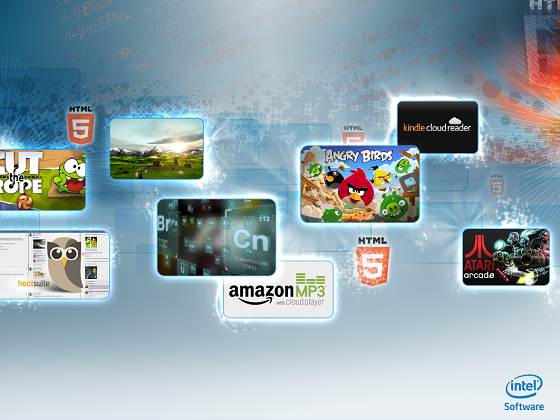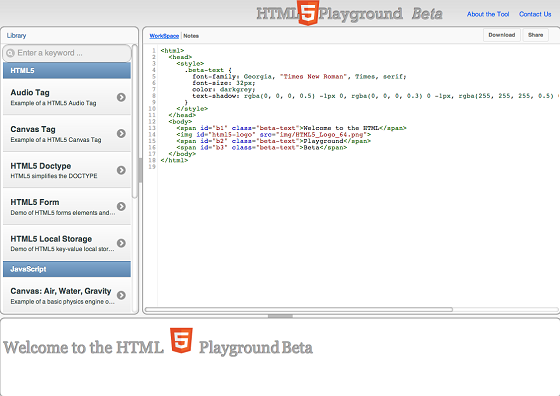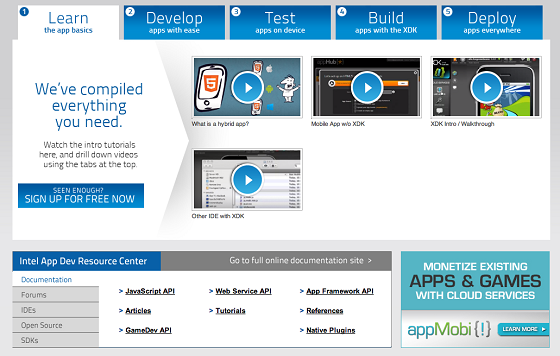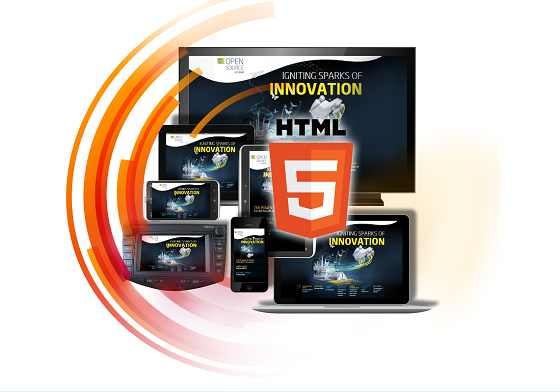There are a lot of reasons to like HTML5. It’s advanced. It’s open. It’s everywhere. And, it’s versatile.
But Intel loves HTML5 because our vision for the future is a world where developers can create amazing cross-platform experiences that flow freely from device to device, and screen to screen—a world where apps can reach more customers and get to market faster, without boundaries.
HTML5 helps make that world possible.
What is HTML5?
In the early 1990s, HTML started out as a simple markup language for displaying hypertext on the Internet. Then it evolved to include images and layout design.
JavaScript* was added to provide interactivity. And eventually APIs—or core bits of code that provide access to more complex software functions—allowed for more advanced interactivity and the integration of cloud based services.
Cascading Style Sheets were introduced—allowing data to be separated from design—and database-driven, dynamic content became possible. Today, that allows the same content to be displayed in different ways across different devices.
And that’s what HTML5 is—a collection of open and proven web technologies that includes HTML, CSS and a set of JavaScript APIs.
HTML5 is advanced:
With HTML5, developers can build stunning multimedia apps with advanced audio, video and hardware-accelerated 3D graphics.
Other features like storage, security, offline capabilities and performance optimizations—combined with the power of cloud services—make it possible for developers to create web-based applications every bit as sophisticated as native apps.
The applications of HTML5 are boundless—from cross platform apps like HootSuite; to multimedia experiences like Kindle Cloud Reader, the Amazon MP3 store and Netflix video streaming; to artistic, immersive experiences like 3 Dreams of Black; to popular games like Cut the Rope IE, Angry Birds Chrome and Atari Arcade; as well as HTML5 performance enhancements like famo.us.
With HTML5, developers can build stunning multimedia apps with advanced audio, video and hardware-accelerated 3D graphics.
Other features like storage, security, offline capabilities and performance optimizations—combined with the power of cloud services—make it possible for developers to create web-based applications every bit as sophisticated as native apps.
The applications of HTML5 are boundless—from cross platform apps like HootSuite; to multimedia experiences like Kindle Cloud Reader, the Amazon MP3 store and Netflix video streaming; to artistic, immersive experiences like 3 Dreams of Black; to popular games like Cut the Rope IE, Angry Birds Chrome and Atari Arcade; as well as HTML5 performance enhancements like famo.us.
Intel is working to take HTML5 even further, so developers can create the most remarkable, fluid cross-platform experiences.
As a top contributor to more than half the W3C working groups, we’re developing APIs for new device, security and media capabilities.
For example, we lead the W3C’s Near Field Communications (NFC) Working Group, with the mission to develop a standard API for Web applications to access NFC devices.
Intel also hosts a variety of W3C API workshops, such as the November 2012, W3C Automotive API Workshop.
We’re also helping to enable a more powerful and immersive HTML5 platform for the future through River Trail, our open source Parallel JavaScript* technology.
HTML5 is open
Built on open web technologies and W3C standards, HTML5 gives developers the freedom, power and choice to create incredible experiences—smarter, better and at lower cost.
Intel believes that open technologies drive innovation. The benefits are clear:
- Open technologies attract active, vibrant communities and meaningful participation on a worldwide basis.
- Open technologies have a lower cost of entry since developer tools, training and resources tend to be freely available.
- With open technologies, developers are free to innovate at their own speed, without having to wait for updated standards or formal, proprietary releases.
- Open communities are typically based on merit, so the best ideas rise to the top and good solutions are more freely shared.
The result? HTML5 is supported by more than two million developers1 and deployed across all major web browsers and a vast array of mobile devices worldwide.
When it comes to open source, Intel has been committed to furthering innovation through open platforms and technologies for more than two decades. It’s in our DNA.
We’re helping to keep HTML5 open through extensive contributions to open-source projects like WebKit. In fact, we are one of the top contributors to WebKit, with over 500 patches.
And, as a steward of Web Platform Docs, we help put HTML5 resources and documentation at the fingertips of every developer.
HTML5 is everywhere
HTML5 is broadly supported across all major browsers and the web runtimes of many mobile platforms, allowing developers to reach more devices and more users—more effectively.
More than one billion mobile devices will have HTML5 browsers this year, a number that is expected to double by 20162. That means HTML5 developers have the potential to reach billions of devices and billions of customers more efficiently than is possible with a native-code-first development strategy.
As strong supporters of HTML5, we’re working to support developers with the tools and community they need to bring their imagination to life in HTML5—today.
From development, to testing, to deployment, everything HTML5 developers need is at the Intel® HTML5 Zone.
Intel Tools
We’re working to provide developers with the tools and resources they need to take their HTML5 experience to the next level.
- The Intel® HTML5 Development Environment lets developers develop, test and deploy apps more efficiently. With it, developers can build HTML5-based, cross-platform apps; test them across multiple devices and form factors; and deploy them using the Intel® XDK.
- The Intel® HTML5 App Porter Tool (BETA) helps developers translate portions of their iOS* apps into HTML5, allowing them to focus on key porting challenges.
- The Intel® HTML5 Playground (BETA) lets developers see—in real-time—how the changes they make to their code will change the results in their sandbox, which is perfect for developers who are new to HTML5.
Developer challenges
Developers want their apps to reach as many customers as possible. That means they need their apps to work across the widest range of devices. Today, that’s a real challenge because each device comes with a distinct ecosystem, different features, variable screen sizes, and unique operating systems—all brought to market by different carriers with different network capabilities.
As a result, apps developed in native code require custom design, development and support for every device.
Some developers work around this challenge by targeting a single device within a single platform, and then expand to new devices if the app is successful.
Historically—in the U.S.—the iPhone* has been the starting point for many app developers. At first glance, this makes a lot of sense. The iPhone comes with a large installed base. Apple is expected to sell almost 200 million iPhones in 20133 and there is a ready way to reach all of them through the Apple marketplace.
Of course, no developer wants to be limited to a single device, or even a single platform. Developers who have created successful apps will want to deploy them across iOS and Android*, as well as other platforms like Windows* Mobile or Tizen*.
This presents developers with additional challenges. They’ll have to spend time porting and adapting their app for each new platform. They’ll have to spend time customizing their UI for the different screen sizes and pixel densities that come with additional devices. They’ll also have to spend more time with bug fixes, updates and maintaining distinct versions of their app for every platform they’ve deployed on. That can quickly become overwhelming for an independent developer to manage.
Fortunately, with HTML5, developers can deploy cross-platform apps by fine-tuning for the browser versus rewriting native code, or porting multiple versions. In other words, developers can reach more devices and more users—more efficiently—with HTML5.
Screen size done right
Developers can solve the vast majority of their screen size challenges by leveraging the principles of responsive web design alongside the capabilities of HTML5—such as CSS Media Queries—to strictly separate presentation style from content, and adapt a single site for multiple screens.
Intel’s Open Source microsite, pictured here, is a good example of how these practices can be implemented in the real world. Its format seamlessly scales depending on the device and screen.
HTML5 is versatile
The versatility of HTML5 provides developers the opportunity to reach across the entire computing ecosystem— a truly staggering global installed base of more than three billion4 devices!
This type of reach is possible because HTML5 is broadly supported across all major PC browsers and the web runtime environments of most major mobile device platforms. With it, developers have the potential to easily reach hundreds of millions of users and efficiently deploy their apps across platforms as diverse as smart phones, PCs, TVs and in-vehicle infotainment systems.
Most developers find HTML5 technologies like JavaScript* and CSS easier to learn than native programming. That means less time learning a language and more time inventing.
And with HTML5, developers can deploy cross-platform apps by fine-tuning for the browser versus rewriting native code or porting multiple versions.
HTML5 is also fueled by a growing community of open source innovators and freely available development tools. This means developers have a low cost of entry, can implement new ideas at their own speed, and are able to take advantage of a worldwide knowledge base.
Additionally, there is a vibrant world of frameworks libraries and tools to help developers create advanced HTML5 apps efficiently—across platforms, devices and screen sizes.
While it’s true that native programming offers some capabilities that HTML5 can’t, HTML5 is far superior at offering capabilities that work across platforms.
That’s why developers who want to maximize their cross-device opportunity are increasingly developing the core parts of their app with HTML5, and then customizing their apps with the native capabilities of each platform as needed.
A recent Kendo UI survey of 5,000 global developers found that 9 out of 10 plan to use HTML5 in 2013, and that roughly a third are already building hybrid apps with a combination of HTML5 and native capabilities.
In essence, HTML5 provides a foundation for developers to reach the largest cross-platform, cross-device opportunity.
Polyfills are a great example of the versatility of HTML5 (Polyfill is a term coined by Remy Sharp, a JavaScript and jQuery developer in the UK.)
A polyfill is a piece of code (or plugin) that provides the technology needed to fill gaps when the browser is unable to support it natively or consistently across platforms. It essentially flattens the API landscape, masks browser and runtime differences, and makes it easier for developers to deploy across platforms through productivity-enhancing abstractions.
There are polyfills that will help developers adapt HTML5 for individual platforms, like Phone Gap. Others—like jQuery Mobile and Twitter Bootstrap—help solve screen size challenges. There are polyfills for implementing Touch UI—such as Sencha Touch—as well as polyfills that help improve HTML5 Performance and 3D UI Elements, like famo.us.
HTML5 is now
HTML5 is a perfect fit for developers who need to innovate fast for a multi-device world. It’s advanced, it’s open, it’s everywhere, and it offers developers the versatility they need to differentiate themselves and get to market faster.
That’s why Intel loves HTML5. And it’s why developers love HTML5 too.
So if you’re not using HTML5 today, what are you waiting for?
Visit the Intel HTML5 zone today at software.intel.com/html5 to see what Intel is doing to help developers reach their full cross-platform potential.
1https://visual.ly/community/Infographics/technology/idc-next-level-mobile-web and http://www.idc.com/getdoc.jsp?containerId=prUS23480612#.UTrDn9FAS3l
2Data Source: IDC for 2013 and ABI for 2016
3https://www.zdnet.com/article/apple-forecast-to-sell-102m-ipads-194m-iphones-in-2013-analyst/
4Internet Trends, Mary Meeker, 12/03/12
Source Intel Software Adrenaline
























